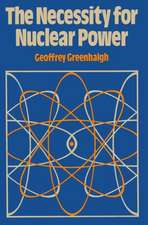Light, Water, Hydrogen: The Solar Generation of Hydrogen by Water Photoelectrolysis
Editat de CRAIG GRIMES, OOMMAN VARGHESE, SUDHIR RANJANen Limba Engleză Hardback – 4 dec 2007
| Toate formatele și edițiile | Preț | Express |
|---|---|---|
| Paperback (1) | 957.44 lei 6-8 săpt. | |
| Springer Us – 6 iun 2011 | 957.44 lei 6-8 săpt. | |
| Hardback (1) | 963.77 lei 6-8 săpt. | |
| Springer Us – 4 dec 2007 | 963.77 lei 6-8 săpt. |
Preț: 963.77 lei
Preț vechi: 1175.34 lei
-18% Nou
Puncte Express: 1446
Preț estimativ în valută:
184.44€ • 191.85$ • 152.27£
184.44€ • 191.85$ • 152.27£
Carte tipărită la comandă
Livrare economică 14-28 aprilie
Preluare comenzi: 021 569.72.76
Specificații
ISBN-13: 9780387331980
ISBN-10: 0387331980
Pagini: 546
Ilustrații: XXII, 546 p.
Dimensiuni: 155 x 235 x 32 mm
Greutate: 0.97 kg
Ediția:2008
Editura: Springer Us
Colecția Springer
Locul publicării:New York, NY, United States
ISBN-10: 0387331980
Pagini: 546
Ilustrații: XXII, 546 p.
Dimensiuni: 155 x 235 x 32 mm
Greutate: 0.97 kg
Ediția:2008
Editura: Springer Us
Colecția Springer
Locul publicării:New York, NY, United States
Public țintă
ResearchCuprins
From Hydrocarbons to Hydrogen: Towards a Sustainable Future.- Hydrogen Generation by Water Splitting.- Photoelectrolysis.- Oxide Semiconducting Materials as Photoanodes.- Oxide Semiconductors Nano-Crystalline Tubular and Porous Systems.- Oxide Semiconductors: Suspended Nanoparticle Systems.- Non-Oxide Semiconductor Nanostructures.- Photovoltaic - Electrolysis Cells.
Recenzii
From the reviews:
"The ‘Holy Grail’ of artificial photosynthesis, particularly for hydrogen production, is often traced … . This book deals with this field, largely from the point-of-view of solid-state synthesis and engineering. … The book is useful for getting brief descriptions of the huge literature on oxide semiconductors prepared in different ways and their behavior. … if oxide materials, and especially TiO2 nanostructures, are of major interest, this book will be useful in traversing the massive literature in this field." (Allen J. Bard, Journal of the American Chemical Society, Vol. 130 (26), 2008)
"Grimes and colleagues (all, Pennsylvania State Univ.) have done a marvelous, meticulous job of collecting the latest developments in hydrogen evolution by nontraditional means to prepare the reader to understand and appreciate the importance of semiconductor photoelectrolysis in the energy future. … The logically developed chapters are copiously referenced (more than 1,000 references listed) and liberally annotated with graphs, tables, and other illustrative diagrams. Summing Up: Highly recommended. Upper-division undergraduate through professional collections." (S. R. Walk, CHOICE, Vol. 45 (11), July, 2008)
"The ‘Holy Grail’ of artificial photosynthesis, particularly for hydrogen production, is often traced … . This book deals with this field, largely from the point-of-view of solid-state synthesis and engineering. … The book is useful for getting brief descriptions of the huge literature on oxide semiconductors prepared in different ways and their behavior. … if oxide materials, and especially TiO2 nanostructures, are of major interest, this book will be useful in traversing the massive literature in this field." (Allen J. Bard, Journal of the American Chemical Society, Vol. 130 (26), 2008)
"Grimes and colleagues (all, Pennsylvania State Univ.) have done a marvelous, meticulous job of collecting the latest developments in hydrogen evolution by nontraditional means to prepare the reader to understand and appreciate the importance of semiconductor photoelectrolysis in the energy future. … The logically developed chapters are copiously referenced (more than 1,000 references listed) and liberally annotated with graphs, tables, and other illustrative diagrams. Summing Up: Highly recommended. Upper-division undergraduate through professional collections." (S. R. Walk, CHOICE, Vol. 45 (11), July, 2008)
Notă biografică
Craig A. Grimes received B.S. degrees in Electrical Engineering and Physics from the Pennsylvania State University in 1984, and the Ph.D. degree in Electrical and Computer Engineering from the University of Texas at Austin in 1990. In 1990 he joined the Lockheed Palo Alto Research Laboratory where he worked on artificial dielectric structures. From 1994 to 2001 Dr. Grimes was a member of the Electrical and Computer Engineering Department at the University of Kentucky, where he was the Frank J. Derbyshire Professor. He is currently a Professor at the Pennsylvania State University, University Park. His research interests include solar generation of hydrogen by water photoelectrolysis, remote query chemical and environmental sensors, nano-dimensional metal-oxide thin film architectures, and propagation and control of electromagnetic energy. He has contributed over 150 archival journal publications, eight book chapters, and over fifteen patents. He is Editor-in-Chief of Sensor Letters, co-author of the book The Electromagnetic Origin of Quantum Theory and Light published by World Scientific (2nd Edition, 2005), and Editor of The Encyclopedia of Sensors to be published by American Scientific Publishing in 2005.
Textul de pe ultima copertă
The development of a direct, inexpensive, and efficient method for converting solar energy into a portable, clean fuel would allow elimination of the growing problems associated with the ever increasing use of fossil fuels and the reality of their rapid depletion. As the title suggests, Light, Water, Hydrogen: The Solar Generation of Hydrogen by Water Photoelectrolysis, considers the combination of water and light with a suitable semiconductor to achieve a safe, renewable and therefore inexhaustable means for hydrogen generation via the splitting of the water molecule, or photoelectrolysis.
The authors consider the impact of recent advances in nanotechnology on the water photoelectrolysis field, providing specific examples as well as the theories and methods necessary for achieving useful water photoelectrolysis systems. Written for users in a wide range of disciplines, including materials scientists, chemists, electrical engineers, and physicists, Light, Water, Hydrogen: The Solar Generation of Hydrogen by Water Photoelectrolysis is an up-to-date, invaluable resource for graduate students and researchers.
The authors consider the impact of recent advances in nanotechnology on the water photoelectrolysis field, providing specific examples as well as the theories and methods necessary for achieving useful water photoelectrolysis systems. Written for users in a wide range of disciplines, including materials scientists, chemists, electrical engineers, and physicists, Light, Water, Hydrogen: The Solar Generation of Hydrogen by Water Photoelectrolysis is an up-to-date, invaluable resource for graduate students and researchers.
Caracteristici
Focus is on development of a useful, cost-effective photochemically stable material system for water photoelectrolysis Addresses three fundamental material science challenges: the need for renewable, portable and non-polluting source of energy, the need for a clean, portable source of energy as durable as sunlight, hydrogen generation by water photoelectrolysis using n-type TiO2
























